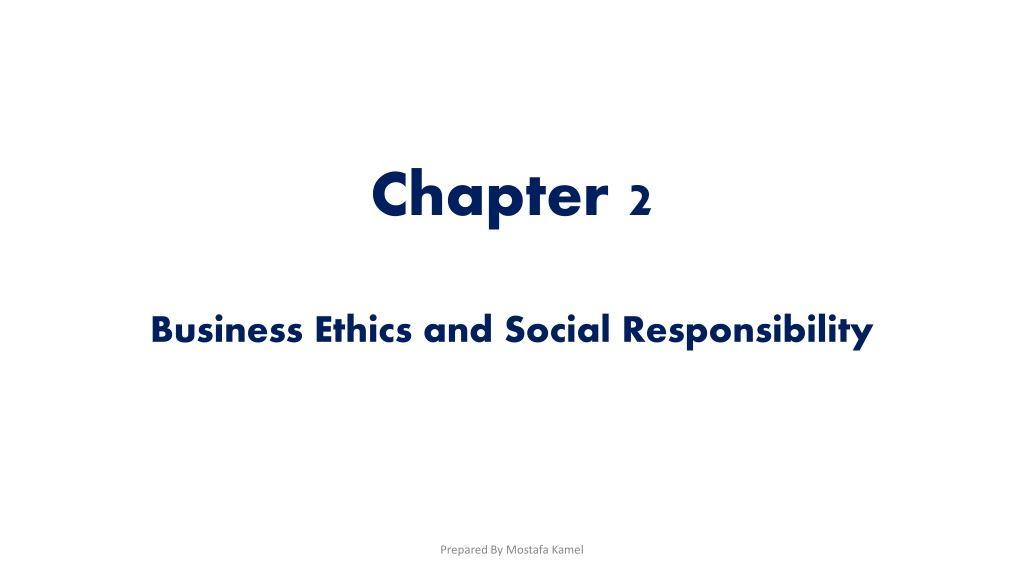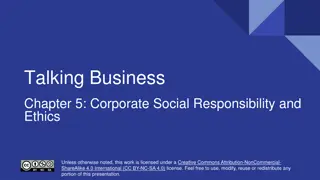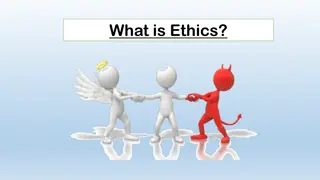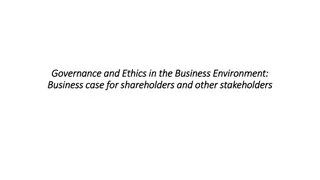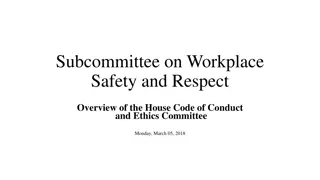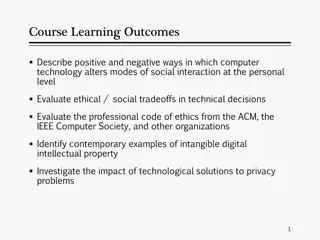Business Ethics and Social Responsibility Overview
This content delves into the intricacies of business ethics and social responsibility, covering topics such as individual ethics, managerial ethics, stakeholder models, and areas of social responsibility like environmental concerns and relationships with customers, employees, and investors.
Download Presentation

Please find below an Image/Link to download the presentation.
The content on the website is provided AS IS for your information and personal use only. It may not be sold, licensed, or shared on other websites without obtaining consent from the author.If you encounter any issues during the download, it is possible that the publisher has removed the file from their server.
You are allowed to download the files provided on this website for personal or commercial use, subject to the condition that they are used lawfully. All files are the property of their respective owners.
The content on the website is provided AS IS for your information and personal use only. It may not be sold, licensed, or shared on other websites without obtaining consent from the author.
E N D
Presentation Transcript
Chapter 2 Business Ethics and Social Responsibility Prepared By Mostafa Kamel
Learning Objectives Explain how individuals develop their personal codes of ethics and why ethics are important in the workplace. Distinguish social responsibility from ethics, identify organizational stakeholders, and characterize social consciousness today. Show how the concept of social responsibility applies both to environmental issues and to a firm s relationships with customers, employees, and investors. Explain how issues of social responsibility and ethics affect small business. Prepared By Mostafa Kamel
Chapter Outline A. Ethics in the Workplace Individual Ethics Business and Management Ethics Company Practices and Business Ethics B. Social Responsibility The Stakeholder Model of Responsibility C. Areas of Social Responsibility Responsibility toward the Environment. Responsibility toward the Customers. Responsibility toward the Employees. Responsibility toward the Investors. D. Social Responsibility and the Small Business Prepared By Mostafa Kamel
Ethics in the Workplace Prepared By Mostafa Kamel
Ethics are beliefs about wrong and right or bad and good. Ethical Behavior: behaviorconforming to generally accepted social norms concerning beneficial and harmful actions. Unethical Behavior is behavior that does not conform to generally accepted social norms concerning beneficial and harmful actions. Business Ethics refers to ethical or unethical behaviors by employees in the context of their jobs. Prepared By Mostafa Kamel
Individual Ethics Because ethics are based on both individual beliefs and social concepts, they vary from person to person, from situation to situation, and from culture to culture. Social standards are broad enough to support differences in beliefs. Ambiguity!! Prepared By Mostafa Kamel
Business and Managerial Ethics Managerial ethics are the standards of behavior that guide individual managers in their work. It is classified in terms of three broad categories: 1. Behavior toward employees. This category covers hiring and firing, wages and working conditions, and privacy and respect. It should based only on the ability to perform a job and not to discriminate against specific sex, color, or religion. 2. Behavior toward the organization. Conflict of interest, confidentiality, and honesty are ethical issues. Example could be, Selling trade secrets. 3. Behavior toward other economic agents. Ethics also comes into play in the relationship between the firm and a number of primary agents of interests, such as customers, suppliers, competitors, stockholders, dealers, and unions. Prepared By Mostafa Kamel
Company Practices and Business Ethics Two of most common approaches to formalize top management commitment to ethical business practices are: 1. Adopting written ethical codes that formally announce their intent to do business in an ethical manner. Such as The HP Way since 1975. 2. Instituting ethics programs through periodic ethics training to remind managers of the importance of ethical decision making and to update them on the most current laws regulations that might be particularly relevant to their firms. Examples could be Exxon mobile and Boing. - Ethical hot lines to report any unethical behavior Prepared By Mostafa Kamel
Social Responsibility Prepared By Mostafa Kamel
Social Responsibility: Is the attempt of a business to balance its commitments to individuals and groups in its environment, including customers, other businesses, employees, investors, and local communities. These individuals and groups are often called Organizational Stakeholders. Organizational Stakeholders: Those groups, individuals, and organizations that are directly affected by the practices of an organization and who therefore have a stake in its performance Prepared By Mostafa Kamel
The Stakeholder Model of Responsibility Most companies that strive to be responsible to their stakeholders concentrate first and foremost on five main groups: Customers: Honor warranties, meet delivery commitments, charge fair prices Employees: Treat them fairly, make them part of the team, respect their dignity. Investors: we should provide accurate financial info., protect their rights and investments. Suppliers: We Negotiate delivery schedules, keep them informed with future plans Local Communities: involve in charitable programs, strive to be good corporate citizens by minimizing their negative impact on communities. Prepared By Mostafa Kamel
Areas of Social Responsibility Prepared By Mostafa Kamel
When defining its sense of social responsibility, a firm typically confronts four areas of concern: Responsibilities toward: Environment: Reduces and prevents Air, Water, and Land Pollution. Customers: Protect Consumer rights, avoid Unfair pricing (Collusion), and ethics in advertising. Employees: Legal (Equal opportunities) and Social (Work-life balance) Commitment. Investors: fights against Improper financial management (Insider trading and misrepresentation of finances) Click here to know Unilever s Sustainable plan .. Prepared By Mostafa Kamel
Social Responsibility and the Small Business Prepared By Mostafa Kamel
Social Responsibility and the Small Business Can small business afford a social agenda? Should it make donations to charitable? Small business owners are faced by the same ethical dilemmas as the large companies that we more frequently read about. Difference are primarily differences of scale. It is important that small companies develop ethical policies and procedures like their larger counterparts. Small businesses can often get advice from trade organizations or state governments to help them develop ethical codes of practices Prepared By Mostafa Kamel
